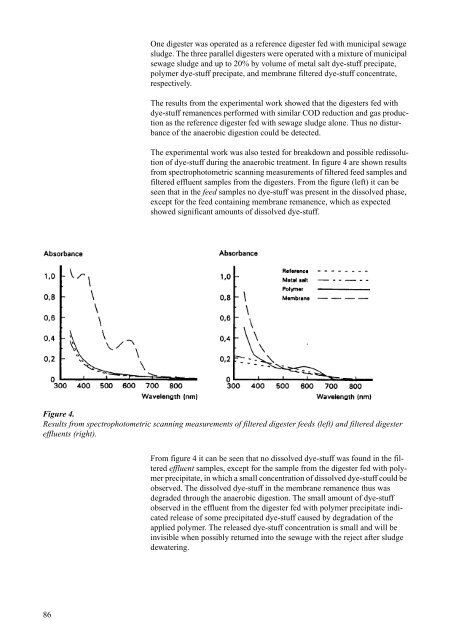Cleaner Technology Transfer to the Polish Textile ... - Miljøstyrelsen
Cleaner Technology Transfer to the Polish Textile ... - Miljøstyrelsen
Cleaner Technology Transfer to the Polish Textile ... - Miljøstyrelsen
Create successful ePaper yourself
Turn your PDF publications into a flip-book with our unique Google optimized e-Paper software.
86<br />
One digester was operated as a reference digester fed with municipal sewage<br />
sludge. The three parallel digesters were operated with a mixture of municipal<br />
sewage sludge and up <strong>to</strong> 20% by volume of metal salt dye-stuff precipate,<br />
polymer dye-stuff precipate, and membrane filtered dye-stuff concentrate,<br />
respectively.<br />
The results from <strong>the</strong> experimental work showed that <strong>the</strong> digesters fed with<br />
dye-stuff remanences performed with similar COD reduction and gas production<br />
as <strong>the</strong> reference digester fed with sewage sludge alone. Thus no disturbance<br />
of <strong>the</strong> anaerobic digestion could be detected.<br />
The experimental work was also tested for breakdown and possible redissolution<br />
of dye-stuff during <strong>the</strong> anaerobic treatment. In figure 4 are shown results<br />
from spectropho<strong>to</strong>metric scanning measurements of filtered feed samples and<br />
filtered effluent samples from <strong>the</strong> digesters. From <strong>the</strong> figure (left) it can be<br />
seen that in <strong>the</strong> feed samples no dye-stuff was present in <strong>the</strong> dissolved phase,<br />
except for <strong>the</strong> feed containing membrane remanence, which as expected<br />
showed significant amounts of dissolved dye-stuff.<br />
Figure 4.<br />
Results from spectropho<strong>to</strong>metric scanning measurements of filtered digester feeds (left) and filtered digester<br />
effluents (right).<br />
From figure 4 it can be seen that no dissolved dye-stuff was found in <strong>the</strong> filtered<br />
effluent samples, except for <strong>the</strong> sample from <strong>the</strong> digester fed with polymer<br />
precipitate, in which a small concentration of dissolved dye-stuff could be<br />
observed. The dissolved dye-stuff in <strong>the</strong> membrane remanence thus was<br />
degraded through <strong>the</strong> anaerobic digestion. The small amount of dye-stuff<br />
observed in <strong>the</strong> effluent from <strong>the</strong> digester fed with polymer precipitate indicated<br />
release of some precipitated dye-stuff caused by degradation of <strong>the</strong><br />
applied polymer. The released dye-stuff concentration is small and will be<br />
invisible when possibly returned in<strong>to</strong> <strong>the</strong> sewage with <strong>the</strong> reject after sludge<br />
dewatering.

















